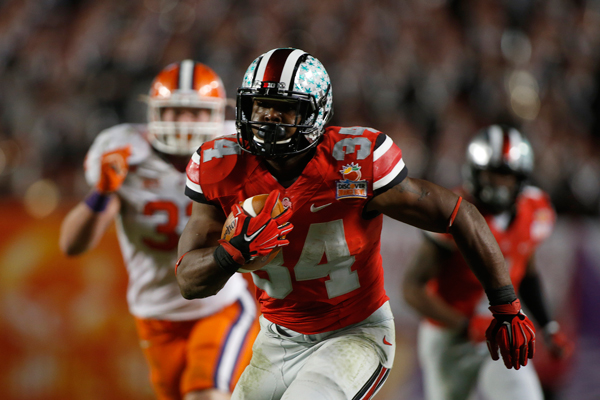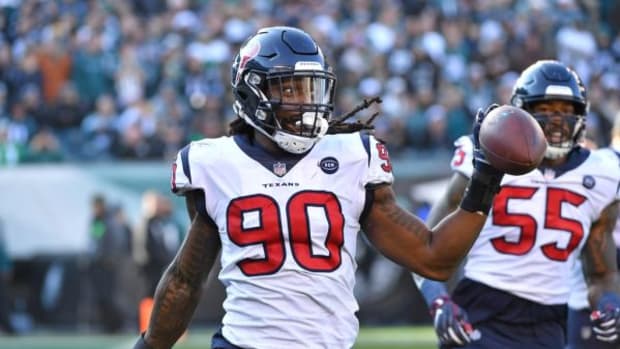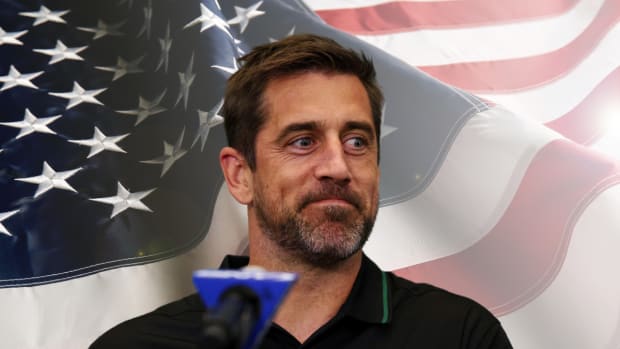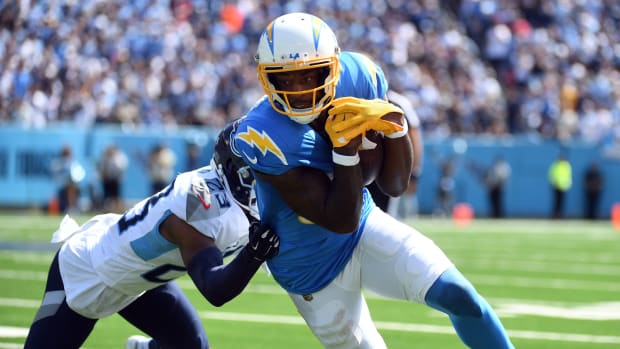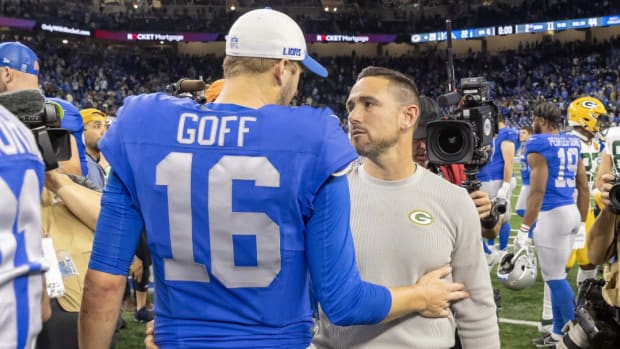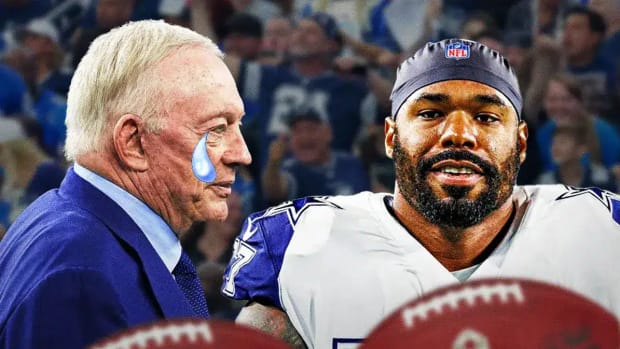2014 NFL draft position rankings: Carlos Hyde headlines running back class
It's a tough time for NFL running backs, but Carlos Hyde is the favorite in this draft class. (Perry Knotts/AP)
There's no question that the running back position has been devalued in recent years at the NFL level. While college backs continue to drive their offenses at major schools, many of those players are in for a rude awakening when they look to cash in at the next level. The 2013 draft marked the first since 1963 in which not one running back was selected in the first round, and the concept of the franchise back has become a thing of the past on most NFL teams.
It's a pass-happy league for the most part, which means that backs who want to become cornerstone players must diversify. Gone are the days when Jim Brown could get away with not blocking for his quarterback -- these days, pass protection is a big deal, if you want to stay on the field and on the roster. And the more routes you can run, the better -- especially if you can do so from different points in the formation.
Adding to that depressing news for this year's class of backs is that not one of them brings the kind of transcendent, no-doubt talent you'd expect of a first-rounder. That doesn't mean that there aren't several backs who will make a big difference in their new homes -- and here are the 10 backs we think have the best chance of doing so.
MORE: 2014 NFL Mock Draft Database | Top centers | Top guards | Top tackles
1. Carlos Hyde, Ohio State: The first running back ever to run for over 1,000 for a team coached by Urban Meyer, Hyde may be the only back in this draft class combining the kind of power and speed that would make him a franchise back at the NFL level. Hyde hit 1,521 yards on just 208 carries in his senior season, despite missing the season's first three games due to suspension following an alleged assault. At 6-foot and 230 pounds, he's got legitimate power up the middle. What makes him special, and what showed up on tape so often last season, is that Hyde also has enough short-area speed and "wiggle" to elude tacklers.
"I think my game is what separates me," Hyde said at the scouting combine. "What I bring to the table? I bring that passion. I play with a lot of heart. I feel like I bring that spark to the offense. When the offense needs something going, I feel like I can make it happen."
He proved that down the stretch, gaining at least 100 yards in his last nine collegiate games, including two 200-yard performances.
Draft projection: Round 2
MORE: Hyde breaks down how he's training for 2014 NFL draft
2. Ka'Deem Carey, Arizona: Carey ran for 1,885 yards on 349 carries last year, but he had proven to be the workhorse of the Wildcats offense the season before, when he led the nation with 1,929 yards, and 2,232 yards from scrimmage. A decade ago, such numbers would have virtually guaranteed Carey a first-round grade, but aside from the general dissolution of his positional value, Carey is also dealing with a lack of next-level speed on the field, the perception that backs in a Rich Rodriguez offense aren't prepped for success and a host of off-field incidents in his past. But his productivity and overall skillset should see him go fairly early in the second day of the draft.
Draft projection: Round 2
3. Tre Mason, Auburn: "If I had to compare [myself to somebody], it would probably be somebody like Marshawn Lynch, along the lines of that. I can beat you inside, outside, anyway. Over you, through you, around you, find a way to get six points."
That's what Mason said of his running style when asked about it at the combine, and he definitely found ways to succeed in 2013, gaining 1,816 yards and scoring 23 rushing touchdowns. He broke Bo Jackson's single-season school rushing mark on his last collegiate carry, and goes to the next level as an interesting option for a number of reasons. Mason stands under 5-9, but at 207 pounds and with 4.5 speed, he's got a good palette of skills for the position. The Lynch comparison is a bit of a stretch -- he's a bit more like Ray Rice -- but with a lot of good tape against SEC defenses, Mason could be the second (or even the first) back taken.
Draft projection: Round 2-3
4. Bishop Sankey, Washington: Sankey gained 3,309 yards and scored 36 rushing touchdowns on 616 carries in 2012 and ’13, despite the fact that he had a quarterback in Keith Price who was inconsistent at best, an average offensive line and a head coach in Steve Sarkisian with one foot out the door. Sankey isn't a pure power back, though he understands how to bounce off contact and pick up extra yards, and his receiving ability is something that many pro teams would find valuable. In a new NFL that values the versatile back, Sankey's ahead of the game.
Draft projection: Round 2-3
5. Devonta Freeman, Florida State: From a pure physical perspective, there's a lot to like about Freeman and his game. He stands 5-8 and weighed 206 at the combine, and he plays both bigger and smaller than that -- bigger in the way he'll take on blockers and fight for extra yard, and smaller in the way he'll burst through the hole as if he weighs about 180 pounds. Freeman averaged 5.9 yards per carry in each of the last two seasons, and he has real potential as a rotation back who can also excel in the passing game.
Draft projection: Round 3
6. Terrance West, Towson: Strength of opponent questions will undoubtedly dog West, but when you isolate his skillset, it becomes clear that the 5-9, 225-pound back can get to the edge in a big hurry, and has an impressive second burst for his size. Academic issues kept him out of the big schools, but as a power back, West doesn't have much of a learning curve.
Draft projection: Round 3-4
7. Jeremy Hill, LSU: At 6-1 and 233 and having faced SEC defenses throughout his collegiate career, Hill certainly looks the part of an NFL running back. And his 1,401 yards and 16 touchdowns against those defenses in 2013 speak to his potential production at the next level. But he might be a bit of a one-trick pony when more is demanded of him -- he's a good straight-line power back, but could struggle to get free when he's the focus of NFL defenses. And the host of off-field red flags won't help his prospects at all -- Hill pled guilty to battery charges in 2013 while he was already on probation.
"I don’t think it’s unfair at all," Hill said at the combine about the perceptions people may have of him. "I put myself in those situations. I can’t really focus on that. All I can do is make the right decisions going forward and put myself in the best position possible. I’m not really focusing on those things. I’ll be opening eyes and getting them the information they need, but I’m not worried about those things, just moving forward."
Draft projection: Round 4-5
8. Andre Williams, Boston College: Williams has certainly seen his share of media exposure, and some analysts believe him to be among the best backs in this class. He led the nation with 355 carries and 2,177 yards in 2013, and that was on a team with few other legitimate offensive weapons. Williams' tape, however, shows a back who takes time to get up to full speed, and though he has good size at 5-11 and 230, there are some questions as to how he would best fit in the NFL.
The good news is that Williams knows he'll have to get better.
“I think my game is going to have to evolve," he said in February. "I think I’m going to be called upon to catch the ball more, pass protect more, know what’s going on, on defense more. Make reads on fronts and coverages faster than before. That’s part of becoming a professional from the amateur level. Upping your level of preparation.”
Draft projection: Round 4-5
9. Lache Seastrunk, Baylor: Seastrunk was ranked among the top handful of prospects coming out of high school, but he sat out the 2011 season after transferring from Oregon back to his home state of Texas. He became the first back ever to run for 1,000 yards in back-to-back seasons for Baylor, and he's a dynamic power back at 5-10 and 200 pounds. However, work will need to be done on his vision and quickness before Seastrunk can blow it up in the pros.
Draft projection: Round 4-5
10. Jerick McKinnon, Georgia Southern: It's a bit of a projection to tag McKinnon with a pure running back role, because he did a bit of everything in college -- from quarterback to H-back to fullback to return man. However, when in the backfield in that more defined role, McKinnon is sure to interest many NFL teams because he runs with power and speed (even if he has a nebulous understanding of the specifics of the position), and in a league where positional versatility is valuable, he could be a surprise player in the right offense.
Draft projection: Third day
































